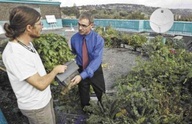| BUFFALO URBAN GARDEN ORGANIZATIONS |
| BUFFALO GROWING - CUFF Curtis Urban Farm Foundation Buffalo's East Side, Buffalo, NY 14212 |
| URBAN ROOTS 428 Rhode Island Street, Buffalo, NY 14213 |
| GRASSROOTS GARDENS 2495 Main Street, Suite #408, Buffalo, NY 14214 |
| BUFFALO BOTANICAL GARDENS 2655 South Park Avenue, Buffalo, NY 14218 |
| WEBSITES |
| BUFFALO GROWING - CUFF http://buffalogrowing.org/book/curtis-urban-farm-foundation |
| URBAN ROOTS http://www.urbanroots.org/ |
| GRASSROOTS http://www.grassrootsgardens.org/ |
| BUFFALO BOTANICAL GARDENShttp://www.buffalogardens.com/ |
Urban Gardens
Every year 1/6th of all American families have no idea where their next meal will come from, and almost 18 million children go to bed hungry every night (1). How can the richest country in the world have men, women and children starving, and how did this problem evolve? On the other end of the spectrum, obesity has become an epidemic in the United States, one that affects 33% of Americans (2). Poor diet is a problem that extends beyond the individual who is more likely to die from heart disease than anything else, including health care and financial hardship.
Health and Goals
The phrase “you are what you eat” is more than a cliché; it’s a hard truth that is easy to forget in the face of a multi-trillion dollar food industry designed to provide instant gratification at an affordable price. Where the problem is most prevalent is in inner cities where access to fresh farm-grown food is scarce as well as expensive, compared to government-subsidized corn-based fast food. Families with limited means are forced to depend on cheap, unhealthy meals, and this results in a higher long-term cost for health related illnesses, such as diabetes, which 25 million Americans suffer from (3). Urban gardening is an attempt to reverse this trend by providing affordable and sustainable food in the places that need it most. Utilizing abandoned buildings and vacant lots usually bought from struggling governments at foreclosure auctions, these gardens use hydroponics to grow large amounts of food at less cost and space than traditional farms. The Curtis Urban Farm Foundation on buffalo’s east side is a non-profit started in 2008 with the goal of providing access to nutritious food while promoting economic self sufficiency. Currently CUFF provides tomatoes, peppers, squash and plans to offer livestock and chickens in the next 2 years. (4)
Land Renewal
With the housing market in a state of collapse since 2008, many state and local governments are inundated with unoccupied land that puts a strain on already razor thin budgets, and as a result, goes without upkeep - effectively creating slums and lowering property values. In Cleveland alone there are some 20,000 vacant lots and 40,000 in Philadelphia (5) and here at home in Buffalo, the city expects to spend $100 million over the next five years to demolish 5,000 abandoned buildings (6). These urban wastelands coupled with all the potential rooftop gardens makes for prime opportunities for non-profit organizations to provide inexpensive food to the disadvantaged. Flat land is a good start, but it is not a requirement nor is it always available. In densely occupied cites such as NYC, many urban gardeners have started vertical farming by using many levels of a building for different crops with gravity providing the necessary means of irrigation. The lower floor of these vertical farms can then act as a street level shop or farmers market where the community can come to get the fresh picked produce (7). In buffalo CUFF has eight raised beds and five large container gardens that total 6 acres and with the common council recently approving the “Buffalo Growing Resolution” that will open up the 8,000 vacant lots currently in city possession to dig ready garden sites. (8) 
Bureaucracy
No good deed goes unpunished and urban gardens are no exception as private interests as well as local officials sometimes hinder or effectively stop garden development. Zoning regulations that are decades old are the primary problem urban gardens face as it is hard to describe the intended benefit, let alone change a law without going through a lengthy court battle. Since urban agriculture is such a new concept it is sometimes easier (as in California) to start a medical marijuana co-op than an urban farm. The public benefit requirement shows up again and again when trying to acquire permits for these gardens, making it easy for local businesses opposed to the community gardens to keep them out. Many of the vacant lots cost upwards of $3.3 million a year for the city to “maintain” and with more lots vacated daily, the cost of keeping the property is becoming a financial burden (9). Funding is a tall mountain to climb as well with few public programs in place and grants falling victim to budget cuts across the country. Local farms have to fight to attract funding.
Public Schools
It takes more than just fresh food availability as people will choose the unhealthy option if not aware of the potential harm they are doing to their health. While it is unethical to force people to eat certain things by means of regulation it can also be argued that not providing a healthy option to those who want it is just as morally void. It is the lack of healthy options in public schools that are becoming troubling to many parents. Urban gardens in school districts that have healthy diet policies provide the schools with their surplus produce free of charge. This practice of produce charity has also met with tough opposition from the companies that currently sell their products in schools as well as hostility from superintendents that depend on food contract revenue to balance budgets and pay for extra curricular programs. Recently there has been growing pressure on schools, especially elementary schools, to force out soda and high-sugar drinks and snacks, however this is not always easy as beverage contracts tend to be for ten years or more and contingent on placement and product type (10),(11). 
Public Policy
The Buffalo and Erie County Botanical Gardens are a deep rooted part of the culture, opened in 1900 and highlighting the parks designed by Fredrick Olmstead the Botanical Gardens are still a major attraction for locals and tourists alike.(12) Public opinion generally supports the idea of urban farms, but as the economy worsens priorities in recent years have shifted and so has the public policy. The current political climate has fostered animosity toward regulatory agencies like the Environmental Protection Agency and the Food and Drug Administration so any attempts at proposing a bill aimed at providing funding to urban agriculture have been shot down before ever seeing the congressional floor. Locally Buffalo has made very little progress in urban gardening and so far Mayor Byron Brown has yet to make a public statement on the subject in his six years as mayor. With so many odds stacked against them urban gardens have the one resilient factor that will bring their success: people will always need to eat and since these farms are primarily independent, passionate projects it is hard to squash individual hope.
The population of the United States is expected to grow by 120 million by 2050 (13) further crowding cites and stressing the food supply past its current breaking point. The food shortages’ scary reality will create an even greater need for localized gardening and will call for a fundamental rethinking of the way we all eat.
Sources: (1) http://feedingamerica.org/hunger-in-america/hunger-facts/hunger-and-poverty-statistics.aspx (2) http://www.cdc.gov/obesity/data/trends.html (3) http://www.diabetes.org/diabetes-basics/diabetes-statistics/ (4) http://buffalogrowing.org/book/curtis-urban-farm-foundation (5) http://www.nytimes.com/2011/08/04/garden/finding-the-potential-in-vacant-lots-in-the-garden.html?ref=urbanagriculture (6) http://www.nytimes.com/2007/09/13/nyregion/13vacant.html (7)http://www.thestarphoenix.com/life/Local+food+systems+carry+great+benefits/5391928/story.html (8) http://buffalogrowing.org/blog (9)http://www.nytimes.com/2010/08/13/us/13bcfarm.html?ref=urbanagriculture (10) http://www.commondreams.org/headlines01/0227-01.htm (11) http://www.nytimes.com/2011/09/20/education/20lunch.html?_r=1&ref=us (12) http://buffalo.wikispot.org/Buffalo_and_Erie_County_Botanical_Gardens (13) http://www.census.gov/population/www/pop-profile/natproj.html http://buffalo.wikispot.org/Buffalo_and_Erie_County_Botanical_Gardens http://www.urbangardensweb.com/ http://sacgardens.org/ http://www.nytimes.com/2011/09/20/education/20lunch.html?_r=1&ref=us




